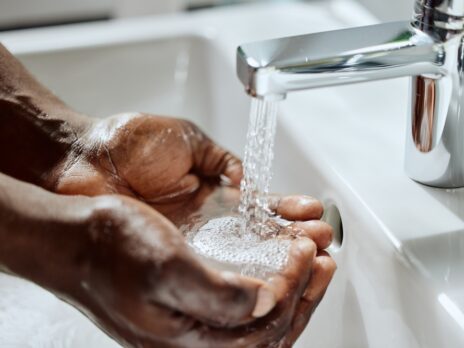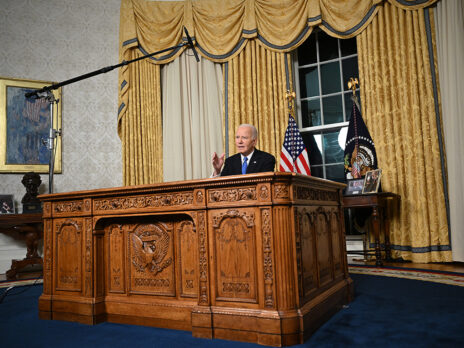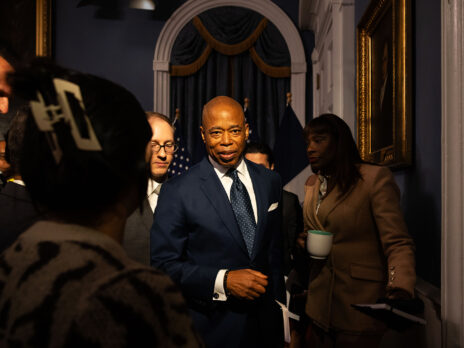On 16 October, with 20 days to go until the election, Kamala Harris strode on to the stage in Washington Crossing, Pennsylvania, to the emphatic chorus of Beyoncé’s anthem “Freedom”. Harris took her position in front of a thicket of American flags, as a carefully chosen group of Republicans clapped along approvingly. (Harris, who has won endorsements from prominent Republicans, has promised to appoint a member of the GOP to her cabinet to return to a pre-Trump tradition of bipartisanship.) The event’s location was significant: this is where George Washington, then the commander of the Continental Army, gathered his troops on Christmas night in 1776 and led them across the icy Delaware River to mount a surprise attack on an enemy garrison. The crossing, immortalised in Emanuel Leutze’s 1851 painting, was a pivotal moment in the American Revolutionary War. After months of gruelling fighting and several defeats, Washington needed a victory.
Harris chose the historic location in Pennsylvania – the most critical swing state in the election – to mount what is effectively her last stand in this extraordinarily close campaign. Not only was this where Washington had embarked on his daring offensive, she explained, but it was close to where America’s Founding Fathers had gathered after victory in that war to write the constitution of the new country, and lay the foundations of its democracy. “At stake in this race are the democratic ideals that our founders and generations of Americans before us have fought for,” she declared. “At stake… is the Constitution of the United States itself.” Harris gestured towards the Republicans standing alongside her. “We are here today because we share a core belief that we must put country before party.” (This is the same slogan used by Keir Starmer’s Labour Party.)
The problem for Harris is that much of the country remains unmoved. As the days and hours tick down, poll after poll shows that the race is effectively tied. The seven swing states that will decide the election – Pennsylvania, Michigan, Wisconsin, Georgia, Arizona, Nevada, and North Carolina – are all locked within the margin of error. No matter Donald Trump’s criminal convictions, his efforts to overturn the previous election, his history of sexual assault, his half-baked policies, and his racist and sexist remarks: close to half of the electorate still plans to vote for him.
For all Harris’s insistence that she represents a “new generation of leadership”, the 60-year-old vice-president has struggled to articulate how her administration would be different from that of Joe Biden, in which she has served for the last three and a half years. She has failed to set out a compelling argument as to how the Democratic Party, now viewed by swathes of the country as the party of the wealthy, identity politics-obsessed liberal elite, will help those struggling with inflation and the cost of living. Added to the persistent complaints that many voters still don’t know enough about Harris’s beliefs, she has boxed herself into an unenviable position as the defender of the status quo – and a political establishment that too many Americans feel is not working for them.
Trump does not have the answers either. His economic plan would increase inflation, hurt manufacturing and lower GDP, according to an assessment by the non-partisan Peterson Institute for International Economics. But he has somehow managed to retain his credentials as an outsider. While Harris talks about the hard work ahead and offers piecemeal strategies to help young families and first-time homeowners, Trump promises easy answers and the satisfaction of “owning the libs”, and taking back Washington from the “radical-left lunatics”. Unless Harris can break through in these final, critical days, Trump will return to power – this time unhindered by the officials who stifled his most dangerous impulses in his first term.
Kamala Harris has long credited her political ascent to the values she learned from her mother. Shyamala Gopalan moved to the US from India in 1958, aged 19, to study nutrition and endocrinology at the University of Berkeley, California. She arrived on campus at the height of the civil rights movement and friends remembered her as being “assertive and intellectually sharp”. She met her future husband, Donald Harris, an economics student from Jamaica who would become a professor at Stanford, at an African American Association study group. They marched together for civil rights and later married.
Kamala was born in 1964, the same year the Civil Rights Act was passed and her mother earned her PhD. Her sister, Maya, was born two years later. Their parents divorced when Kamala was seven and her mother, who became a breast cancer researcher, raised the girls on her own. As a child, Harris was part of an initiative to desegregate public schools, bused from her predominantly black neighbourhood in Berkeley to a predominantly white elementary school. She used the experience to attack Biden during the 2019 Democratic primary debates, when she accused him of opposing the programme that had brought a “little girl in California” to school every day.
The Harris sisters often went with their mother to a community centre founded by a group of local black women that had hosted Maya Angelou, Alice Walker and Nina Simone. “It was where I learned that artistic expression, ambition and intelligence were cool,” Harris wrote in her 2019 memoir, The Truths We Hold.
Harris attended Howard University, a historically black university in Washington DC, founded two years after the end of the Civil War. It was “heaven”, she later recalled. “There were hundreds of people, and everyone looked like me.” She was an unapologetic overachiever who carried a briefcase to class, won a seat on the Liberal Arts Student Council, joined the economics society and the debate team, and was accepted into the nation’s oldest black sorority, Alpha Kappa Alpha. (Harris often wears pearls, a symbol of the sorority.) She marched against apartheid at weekends, worked as a tour guide at the Bureau of Engraving and Printing – a Treasury agency which designs US currency – and interned at the Federal Trade Commission. She graduated with a degree in economics and political science, and returned to California to go to law school.
When Harris told her friends and family she had decided to become a prosecutor, they were “incredulous” that she would pursue a career in an institution synonymous for many with systemic racism. The decision was shaped in part by an experience at high school, when one of her best friends had confided in her that she was being molested by her stepfather and Harris insisted she move in with her family. She wanted to be in a position to help protect the vulnerable and hold abusers like him to account.
But Harris was also drawn to the idea that the most effective way to change the system was to become part of it. In the most revealing passage of her nakedly political memoir, published to coincide with the start of her first presidential campaign, Harris writes that she understood that “part of making change was what I’d seen all my life, surrounded by adults shouting and marching and demanding justice from the outside”. But she also knew there was an “important role on the inside, sitting at the table where the decisions were being made”.
That impulse – to shape the institutions of power from within – is the through-line in Harris’s career. It is part of what made her such a poor fit for the 2020 presidential primary campaign: at a time when the US was roiling with racial-justice protests, “Kamala the cop”, a candidate who was best known as a former prosecutor, inspired no one. Her attempts to retrofit her credentials to appear more left-wing sounded hollow. In fact, Harris has tended to take a remarkably conservative approach to power, arming herself with a briefcase and pearls instead of a megaphone, and seeking admission to the highest echelons.
Contrary to the stereotype of San Francisco as a radically liberal city, the Bay Area’s cut-throat politics nurtured Harris’s pragmatism as she learned how to put together an unwieldy coalition of different groups. The San Francisco Chronicle recalled how Harris, when running for her first public office, as district attorney in 2004, had “somehow united Pacific Heights high society, African Americans in the Bayview, and the LGBTQ community in the Castro”.
Harris won a close race that year and was re-elected as district attorney, unopposed, four years later. She won another tight contest to become California’s attorney general in 2010. She was the first woman, and the first black person and Asian American to serve in both roles. At the time, she was feted as a rising star in Democratic politics, profiled by Oprah Winfrey as a “superstar prosecutor” and dubbed the “female Barack Obama”. When she was elected as a senator in 2016, she was only the second woman of colour to serve in the US Senate.
Listen to the New Statesman podcast
But by the mid-2010s, Harris was already gaining a reputation as a political weathervane. While the Los Angeles Times’s editorial board endorsed her Senate run, praising her as “the persuasive, thoughtful and pragmatic lawmaker California needs”, it also criticised her for having “at times seemed more focused on her political career than on the job she was elected to do”. She had been “unwilling to stake out a position on controversial issues” and prone to “bouts of excessive caution”. She had campaigned for criminal justice reform in her bid for attorney general, for instance, then declined to give an opinion when she was in office on proposals to lower penalties for non-violent offences. As the city’s district attorney in 2004, she refused to seek the death penalty after the murder of a San Francisco police officer, then upheld the use of capital punishment as California’s attorney general.
“She failed for years to hold police accountable for gross misconduct in California, then touted her commitment to police accountability in the wake of George Floyd’s murder,” commented the grassroots organisation Progressive Democrats of America in 2020, accusing Harris of “taking positions broadly palatable to the corporate donor class” and “aligning her stance with the prevailing political winds”.
During her brief career as a senator, she had one of the most progressive voting records in Congress, which included co-sponsoring Senator Bernie Sanders’ Medicare for All Bill in 2017, which would have given all Americans access to a government health insurance programme, and supporting efforts to decriminalise the possession of marijuana. She was best known for her searing interrogations of witnesses in high-profile hearings of the Senate judiciary committee, including the 2018 questioning of soon-to-be Supreme Court justice Brett Kavanaugh, whom she asked whether he could “think of any laws that give the government the power to make decisions about the male body”. (He could not.) But for many on the left, she was still seen as too centrist, too establishment.
Harris entered the race for the 2020 Democratic presidential nomination as one of the front-runners, but she failed to distinguish herself in a crowded field, and swiftly ran out of money as her campaign descended into factional fighting among her senior staff.
“This is my third presidential campaign and I have never seen an organisation treat its staff so poorly,” Kelly Mehlenbacher, the campaign’s state operations director wrote in a leaked resignation letter in November 2019. “Our campaign ‘For the People’ is made up of diverse talent which is being squandered by indecision and a lack of ‘leaders who will lead’.”
Harris dropped out before the first vote was cast – but not before she had done significant damage to her political career. Then, as now, the complaint among voters was that they didn’t really know what she stood for, as she tried to outflank her rivals to the left with a flurry of promises that included banning fracking, decriminalising unauthorised border crossings, and support for “defunding” the police. (She has since changed her stance on all three.) She was seen as standing for everything, and so nothing at all. Fairly or not, given Trump’s own history of flip-flops on a range of issues, that impression – that Harris stands, above all else, for getting elected – still haunts her.
In June 2021, less than five months after taking office as vice-president, Harris sat down for an interview with the NBC anchor Lester Holt in Guatemala, where she was visiting as part of her brief to tackle the root causes of migration to the United States. Entirely predictably, Holt asked Harris whether she had any plans to visit the US border herself. “At some point,” she replied, throwing her hands up in exasperation. “This whole – this whole thing about the border. We’ve been to the border.” “You haven’t been to the border,” Holt interjected. “And I haven’t been to Europe,” Harris responded, laughing awkwardly. “I don’t understand the point that you’re making.”
It was a face-palm moment that came to define Harris’s early tenure. She was “not ready for prime-time”, Washington pundits declared, bemoaning her tendency to speak in “word salads” and the wider public’s general confusion over what her role in the administration involved.
“White House urges Kamala Harris to sit at computer all day in case emails come through” ran a widely shared headline in the Onion in October 2021. There soon followed reports of deep dysfunction within the vice-president’s office, which was beset by rumours of vicious infighting as a series of senior advisers quit. (“We are not making rainbows and bunnies all day,” Harris’s spokesperson Symone Sanders countered.) Even Biden, while publicly maintaining his support for his vice-president, was said to have conceded in private that she was a “work in progress”.
Harris had never wanted the immigration portfolio, which she understood to be an intractable issue and a political vulnerability. Her defenders insisted that she had been given an impossible job, and that she was being judged by unreasonable standards as the first woman, and the first person of colour, ever to serve as vice-president of a country still riven by racism and misogyny. Who could remember what Biden had done as vice-president, for instance? Or, besides certifying the results of the 2020 election, Mike Pence? Yet Harris was also to blame. After her disastrous encounter with Holt, she retreated from the media spotlight, avoiding major interviews for a year. There was open talk inside the Beltway about the “Kamala Harris problem” as her approval ratings plummeted, and rumours circulated that Biden might try to ditch his flailing vice-president by nominating her to the Supreme Court.
But then 81-year-old Biden shuffled on to the stage of the CNN presidential debate in June this year and ignited the crisis that would end his political career. Over the next four weeks, while Democrats implored Biden to drop out of the race, Harris remained publicly loyal. With just over 100 days to go until the election, and a Trump victory looking ever more assured, she declined the opportunity to distance herself from her boss. But privately, she was preparing to run. When Joe Biden called his vice-president on 21 July to tell her that he had decided to step aside, she was ready. Huddled with a small group of trusted aides inside the Naval Observatory – the VP’s official residence in Washington – Harris worked her way down a list of influential Democrats, donors and potential rivals, pressing her case with party grandees such as Barack Obama, Hillary Clinton and Chuck Schumer. Within 48 hours she had effectively cleared the field and secured the Democratic nomination. For a woman who has often been dismissed as being too equivocal, it was a vivid demonstration of her political skill and her ability to be utterly ruthless when required.
In the current race for the White House, Harris was spared a bruising primary, and is campaigning squarely where she has long seemed most comfortable: her party’s centre ground. She has promised thousands in child tax credits for the parents of newborns, $25,000 towards a home down-payment for many Americans, tougher enforcement at the border, and a $50,000 tax deduction for new businesses. These are all reasonable policies aimed at making life incrementally better and fairer for low- and middle-income families, if not as attention-grabbing as Trump’s vow to deliver “the greatest economy in the history of the world”. On foreign policy, too, Harris has indicated that little would change from Biden’s liberal Atlanticism, including continued support for Ukraine, although she is from a younger generation which is markedly less idealistic about America’s role in the world. Her national security adviser, Philip Gordon, has written a book about the “false promise of regime change in the Middle East”.
The most obvious break with Biden is the real passion with which Harris speaks about reproductive rights and the personal freedoms that have been lost since the Supreme Court overturned the constitutional right to abortion in 2022. Earlier this year, she became the first sitting vice-president to visit an abortion clinic. By contrast Biden, a staunch Catholic, could barely bring himself to utter the word “abortion” in public. Harris’s apparently genuine outrage over the rolling back of women’s rights fuels her most powerful campaign slogan: “We are not going back.”

Harris’s presidential campaign, as with much of her career, is a Rorschach test. For many on the right, she is a “dangerously liberal” West Coast radical, as Trump has characterised her, who is beholden to her wealthy donors and the Democratic Party’s politics of pronouns, and oblivious to the concerns of America’s struggling working class. She has been criticised, too, for picking the Minnesota governor, Tim Walz, as her running mate – Walz had to apologise after exaggerating his military service, and for claiming to be in Hong Kong during the Tiananmen Square massacre in 1989 when he was not. For Harris’s critics, the choice of Walz is further proof that she is beholden to her party’s progressive wing.
Yet for many on the left, the problem is that Harris is not radical or progressive enough. She is seen as being too mainstream and too cautious in her approach to the economy and in her reluctance to stand up to Israel over its widening war in the Middle East. She has been criticised for campaigning with Liz Cheney and citing the support of Goldman Sachs – both seen as evidence that she is too hawkish and too conservative. It is notable that leading progressives such as Bernie Sanders and the New York congresswoman Alexandria Ocasio-Cortez urged Biden to stay in the presidential race this summer, even after his calamitous debate, apparently viewing him as a better vehicle for their agenda than Harris. She has been praised, and criticised, over the years for being “shrewd” and “malleable”.
There is also a clear double standard being applied to Trump by many commentators. While the 78-year-old former president has unravelled on the campaign trail, delivering rambling, grievance-laden speeches, refusing to engage in basic policy discussions, refusing to accept that he lost the last election, and, on one memorable occasion, abandoning a town hall to sway along on stage, for almost 40 minutes, to music that included two versions of “Ave Maria” and the song “Memory” from the musical Cats. By contrast, Harris is required to walk an agonisingly narrow line that has never been required of her male counterparts, to prove that she is worthy of the presidency. She must show she is tough – able to serve as commander-in-chief and handle a national emergency at 2am – but not bossy, and definitely not angry. She must be likeable, but not lightweight. She must be maternal – assuaging concerns that she has not personally given birth by explaining that her stepchildren call her “Momala” – but not soft. She should have a sense of humour, just as long as she doesn’t laugh too loudly or for too long.
As Harris made her appeal in Washington Crossing earlier this month, the pre-emptive blame game had already begun. The effervescent joy that characterised her coronation this summer has drained away as her narrow lead has dissipated and the polls have shifted, albeit marginally, towards Trump in recent days. Painfully aware that polling in the last two presidential elections has underestimated support for Trump, senior Democrats fear that the White House is, once again, slipping from their grasp, just as it did when Trump defeated Hillary Clinton in 2016. If Harris falls short, the failure will be attributed to her innate caution as a candidate, her calculating approach to politics, her centrist campaign, her choice of Walz, her attempt to build a broad coalition rather than playing to her base. If she wins, the same strategy will be seen as brilliant.
The biggest danger for Kamala Harris, and the Democrats more broadly, is that they are viewed as representatives of a failing system – the Washington “swamp” that Trump is still promising to drain. At its core, the Democratic Party has always believed in institutional solutions to the country’s problems, from Franklin D Roosevelt’s New Deal in the 1930s to Obamacare last decade. Harris subscribes to the same orthodoxy. She is a pragmatist who views political power as the art of the possible and wants a seat at the table – ideally the head of the table – where the decisions are being made.
But on the other side in this election is an avowed iconoclast who promises to tear that system down and make the elites share some of the wider country’s pain. Trump, demonstrably, does not have the solutions, but he is adept at playing on voters’ fears, and able to articulate convincingly the grievances of the growing share of the electorate that believes the country is headed in the “wrong direction”.
That conviction will not be assuaged by the outcome of this race. The only certainty at this stage, as both sides enter the final, desperate sprint, is that the result will be close, and that the deep divisions that have taken hold across the US will endure far beyond election day. We know, too, that if Trump loses, he has no intention of conceding quietly.
[See also: Labour has become a weapon in Trump’s campaign]
This article appears in the 23 Oct 2024 issue of the New Statesman, The crisis candidate






